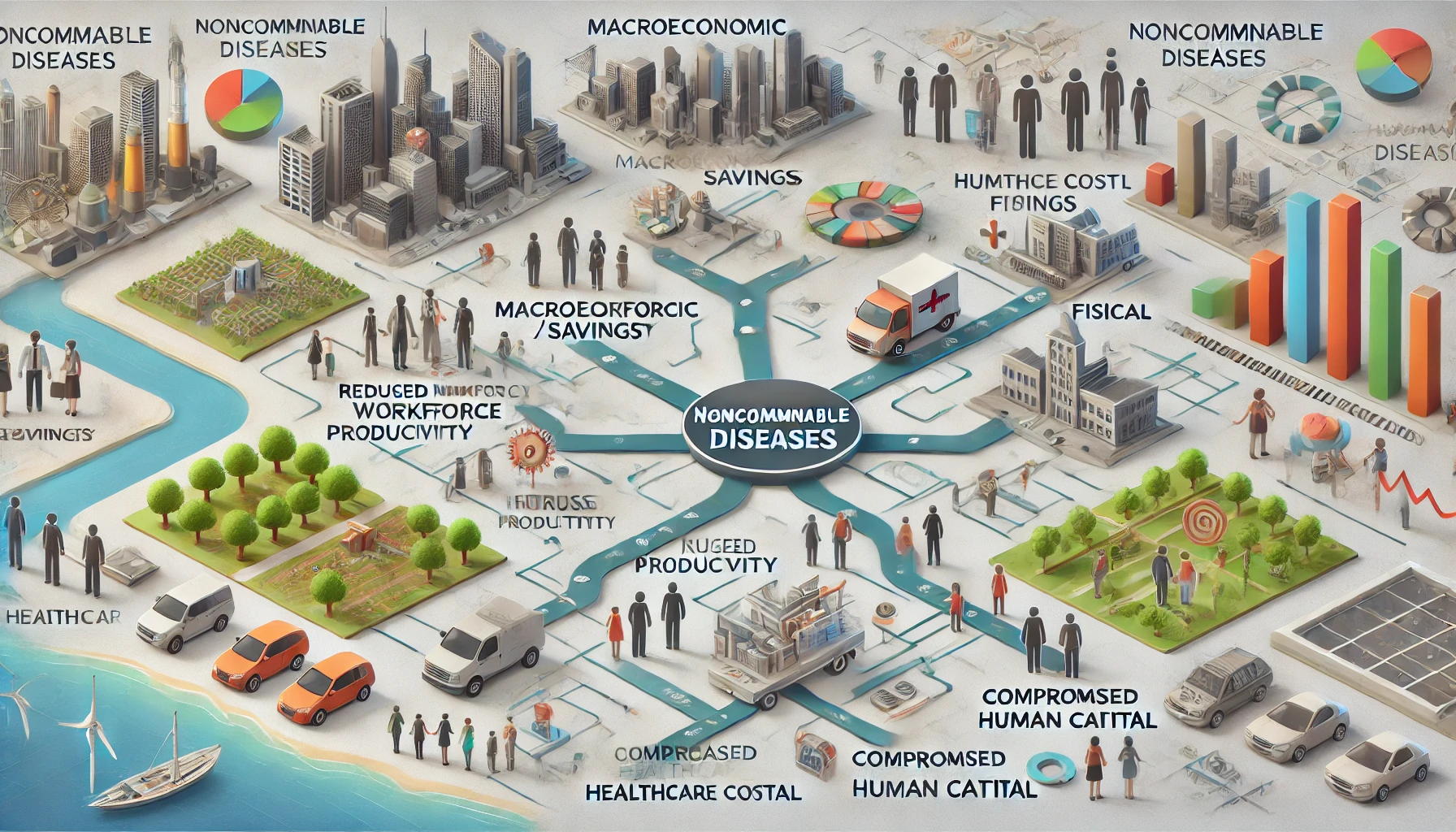The Growing Burden of NCDs: Challenges for Human Capital and Economic Stability
The framework addresses the significant impact of noncommunicable diseases (NCDs) on human capital, economic growth, and well-being in low- and middle-income countries. It highlights key pathways, including macroeconomic, fiscal, and human capital channels, while emphasizing the need for comprehensive policy responses to mitigate these effects across the life course.

The framework in the document developed as part of the World Bank's Healthy Longevity Initiative in collaboration with the University of Toronto and PAHO discussed the growing impact of noncommunicable diseases (NCDs) on human capital, economic growth, and overall well-being, particularly in low- and middle-income countries (LMICs). NCDs, which include cardiovascular diseases, cancers, diabetes, respiratory conditions, and mental health disorders, have become a significant global challenge, affecting not only higher-income nations but increasingly LMICs as well. As these diseases become more prevalent, their effects extend beyond individual health, influencing macroeconomic stability, government spending, and the development of human capital.
Expanding Global Health Challenges with NCDs
The framework outlined in the document is part of the Healthy Longevity Initiative (HLI), which emphasizes the need for a structured global response to address the long-term consequences of NCDs on people’s lives and livelihoods. The Healthy Longevity Initiative complements existing programs like the Human Capital Project (HCP), which focuses primarily on the younger population up to age 18. However, the HLI takes a broader approach by addressing the entire life course, with a specific focus on adulthood and older age, where the impacts of NCDs are particularly pronounced. By connecting the dots between NCDs, human capital, and outcomes such as healthy longevity, inclusive economic growth, and overall well-being, the framework aims to guide policies that will help mitigate the effects of NCDs on global populations.
Key Pathways Impacting Growth and Well-Being
The framework identifies three key pathways through which NCDs impact these outcomes: the macroeconomic/savings channel, the fiscal channel, and the human capital channel. In the macroeconomic/savings channel, NCDs are seen to hinder economic growth by increasing the burden on healthcare systems and reducing workforce productivity, especially in developing countries. The fiscal channel focuses on how the rising costs of healthcare services, coupled with the reduced productivity caused by NCD-related morbidity and mortality, strain government budgets. This strain is felt particularly in LMICs, where the demand for public spending on healthcare rises as NCDs spread, potentially leading to budget deficits and crowding out private sector investments.
Long-Term Effects on Human Capital
The human capital channel explores how NCDs affect the development, deployment, and protection of human capital throughout an individual’s life. NCDs can reduce school attendance and learning outcomes in early childhood, affecting future labor market prospects. In adulthood, NCDs reduce workforce participation due to morbidity, early retirement, and reduced productivity, while in older age, they lead to accelerated depreciation of human capital due to illness and disability. This dynamic creates a cycle in which NCDs not only harm individual health but also have ripple effects on families, particularly in LMICs, where women disproportionately bear the burden of care for family members with NCDs.
Disparities in Health Outcomes and Gender
The document underscores that these issues are more pronounced among poorer populations, who experience higher rates of NCDs and face more significant barriers to accessing healthcare and education. The socioeconomic gradient in NCD incidence means that poorer individuals are more likely to suffer from these diseases and have less access to resources that could mitigate their impact, further widening the gap in human capital development between rich and poor. Gender inequality also plays a significant role, with women not only being more vulnerable to the economic effects of NCDs but also more likely to provide unpaid care for affected family members, limiting their participation in the labor market and further entrenching gender disparities.
Policies for a Healthier Future
The framework also touches on the intergenerational impacts of NCDs, noting how the health of parents affects the human capital of their children, from conception through adulthood. For example, parents’ NCDs can compromise the cognitive development of their children, reducing their future earning potential and ability to contribute productively to the economy. Moreover, as parents age and require more care, their adult children, particularly daughters, may find themselves unable to fully participate in the labor market due to the demands of caregiving. The document emphasizes the need for comprehensive policy responses that address NCDs across the life course, from childhood to old age. These responses include public health interventions, improved healthcare services, better nutrition, and strategies to reduce the risk factors associated with NCDs, such as smoking, poor diet, and physical inactivity. Beyond healthcare, policies that address broader social determinants of health such as environmental quality, road safety, and social security systems are essential for reducing the burden of NCDs and their impact on human capital.
- FIRST PUBLISHED IN:
- Devdiscourse










